MaryAnn Bernal's Blog, page 260
July 11, 2014
Were Ancient Child Skulls Gifts to the Lake Gods?
By Tia Ghose
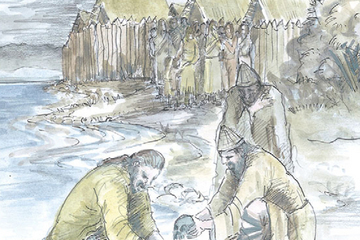
 An illustration of Bronze-Age lake dwellers in Switzerland and Germany, who may have buried children's skulls at the perimeter of their settlements as gifts to lake gods to ward off flooding.
An illustration of Bronze-Age lake dwellers in Switzerland and Germany, who may have buried children's skulls at the perimeter of their settlements as gifts to lake gods to ward off flooding.
Credit: Benjamin Jennings et al, Antiquity 2014
Children's skulls found at the edges of Bronze Age settlements may have been a gruesome gift for the local lake gods.
The children's skulls were discovered encircling the perimeter of ancient villages around lakes in Switzerland and Germany. Some had suffered ax blows and other head traumas.
Though the children probably weren't human sacrifices killed to appease the gods, they may have been offered after death as gifts to ward off flooding, said study co-author Benjamin Jennings, an archaeologist at Basel University in Switzerland.
Lake dwellers
Since the 1920s, archaeologists have known that ancient villages dotted Alpine lakes in Switzerland and Germany. However, it wasn't until the 1970s and 1980s that many of the sites were excavated, yielding hunting tools, animal bones, ceramics, jewelry, watchtowers, gates and more than 160 dwellings. Tree rings on wooden artifacts from the sites suggest people lived there at different periods between 3,800 and 2,600 years ago. [Mummy Melodrama: Top 9 Secrets About Otzi the Iceman]
The Bronze Age lake dwellers regularly faced flooding. Whenever lake levels rose, they would pick up and move to dry land, only to return once the waters receded. To adapt to this watery threat, the people built houses on stilts or on sturdy wooden foundations, and created palisades, or fences, made from bog pine, the researchers wrote in the June issue of the journal Antiquity.
But in addition to finding evidence for such architectural adaptations, archaeologists also unearthed more macabre details of life (and death): children's skulls and skeletal remains encircling the villages at the palisade edges. Many of these ancient skulls were placed there long after their initial burial, at a time when the settlements experienced the worst inundation from rising lake levels, the researchers wrote.
Gift to the gods
In the current study, Jennings and his colleagues took a closer look at the fossil skeletons.
Most were from children under age 10, and though the skeletal remains revealed tooth decay and signs of respiratory ailments, those health troubles would not have been severe enough to warrant a mercy killing, the researchers wrote in the journal article.
The skulls showed evidence of head trauma from battle-axes or clubs, though the injuries don't have the uniformity associated with a ritual killing. As a result, it's more likely the youngsters were felled in warfare, rather than killed as a sacrifice for the gods, the researchers wrote.
Either way, it's clear these weren't ordinary burials, he said.
"Across Europe as a whole there is quite a body of evidence to indicate that throughout prehistory human remains, and particularly the skull, were highly symbolic and socially charged," Jennings told Live Science in an email.
At these sites, "the remains are found at the perimeter of the settlement — not inside and not outside, but at a liminal position on the border between in and out," Jennings added. And at one of the sites, the remains were placed at the high-water mark of the floodwaters. Taken together, the details of the burial suggest the remains were placed as an offering to protect against flooding, Jennings said.
Still, there are many unanswered questions about these mysterious Alpine people.
"There are very few instance or examples of burials in the vicinity of the lake settlements, and so we really do not know where the majority of the lake dwellers are buried, or how they treated their dead," Jennings said.
http://www.livescience.com/46712-ancient-child-burials-switzerland.html


 An illustration of Bronze-Age lake dwellers in Switzerland and Germany, who may have buried children's skulls at the perimeter of their settlements as gifts to lake gods to ward off flooding.
An illustration of Bronze-Age lake dwellers in Switzerland and Germany, who may have buried children's skulls at the perimeter of their settlements as gifts to lake gods to ward off flooding.Credit: Benjamin Jennings et al, Antiquity 2014
Children's skulls found at the edges of Bronze Age settlements may have been a gruesome gift for the local lake gods.
The children's skulls were discovered encircling the perimeter of ancient villages around lakes in Switzerland and Germany. Some had suffered ax blows and other head traumas.
Though the children probably weren't human sacrifices killed to appease the gods, they may have been offered after death as gifts to ward off flooding, said study co-author Benjamin Jennings, an archaeologist at Basel University in Switzerland.
Lake dwellers
Since the 1920s, archaeologists have known that ancient villages dotted Alpine lakes in Switzerland and Germany. However, it wasn't until the 1970s and 1980s that many of the sites were excavated, yielding hunting tools, animal bones, ceramics, jewelry, watchtowers, gates and more than 160 dwellings. Tree rings on wooden artifacts from the sites suggest people lived there at different periods between 3,800 and 2,600 years ago. [Mummy Melodrama: Top 9 Secrets About Otzi the Iceman]
The Bronze Age lake dwellers regularly faced flooding. Whenever lake levels rose, they would pick up and move to dry land, only to return once the waters receded. To adapt to this watery threat, the people built houses on stilts or on sturdy wooden foundations, and created palisades, or fences, made from bog pine, the researchers wrote in the June issue of the journal Antiquity.
But in addition to finding evidence for such architectural adaptations, archaeologists also unearthed more macabre details of life (and death): children's skulls and skeletal remains encircling the villages at the palisade edges. Many of these ancient skulls were placed there long after their initial burial, at a time when the settlements experienced the worst inundation from rising lake levels, the researchers wrote.
Gift to the gods
In the current study, Jennings and his colleagues took a closer look at the fossil skeletons.
Most were from children under age 10, and though the skeletal remains revealed tooth decay and signs of respiratory ailments, those health troubles would not have been severe enough to warrant a mercy killing, the researchers wrote in the journal article.
The skulls showed evidence of head trauma from battle-axes or clubs, though the injuries don't have the uniformity associated with a ritual killing. As a result, it's more likely the youngsters were felled in warfare, rather than killed as a sacrifice for the gods, the researchers wrote.
Either way, it's clear these weren't ordinary burials, he said.
"Across Europe as a whole there is quite a body of evidence to indicate that throughout prehistory human remains, and particularly the skull, were highly symbolic and socially charged," Jennings told Live Science in an email.
At these sites, "the remains are found at the perimeter of the settlement — not inside and not outside, but at a liminal position on the border between in and out," Jennings added. And at one of the sites, the remains were placed at the high-water mark of the floodwaters. Taken together, the details of the burial suggest the remains were placed as an offering to protect against flooding, Jennings said.
Still, there are many unanswered questions about these mysterious Alpine people.
"There are very few instance or examples of burials in the vicinity of the lake settlements, and so we really do not know where the majority of the lake dwellers are buried, or how they treated their dead," Jennings said.
http://www.livescience.com/46712-ancient-child-burials-switzerland.html

Published on July 11, 2014 16:23
Korean Mummy's Hernia Diagnosed 300 Years Later

 An arrow points to the hole in the mummy's diaphragm, through which the liver (labeled Lv) is protruding, pushing up against the lung.
An arrow points to the hole in the mummy's diaphragm, through which the liver (labeled Lv) is protruding, pushing up against the lung.Credit: PLOS ONE View full size image
By Megan Gannon
This diagnosis is 300 years too late.
An autopsy of a Korean mummy entombed in the 17th century shows that the middle-age man suffered from a potentially painful hernia during his lifetime, according to a new study.
The mummy, only discovered last year, had been buried in a royal tomb of Korea's Chosun (or Joseon) Dynasty in Andong, a city in modern-day South Korea. The well-preserved remains belonged to a man who was about 45 years old and 5 feet, 3 inches (160.2 cm), the researchers said in their report published this month in the journal PLOS ONE. Based on his topknot hairstyle, archaeologists concluded that the man was married.
Before he died, the middle-age man may have roamed the streets of Andong with pain in his chest and abdomen. Perhaps he was sometimes short of breath or nauseated. But he wouldn't have known what was wrong with him; doctors have only been able to diagnose his condition, known as Bochdalek-type congenital diaphragmatic hernia (CDH), with the advent of radiological imaging technologies, such as X-ray and computed tomography (CT) scans, in the 20th century.

[image error]
 A 17th-century male mummy, called the Andong mummy, who was diagnosed with a diaphragmatic hernia.
A 17th-century male mummy, called the Andong mummy, who was diagnosed with a diaphragmatic hernia.Credit: doi:10.1371/journal.pone.0099779.g003
View full size imageBochdalek hernias arises from a birth defect that causes a hole in the diaphragm, the dome-shaped muscle that stetches across the bottom of the lungs. Other organs in the abdomen might push through this hole into the chest cavity, compressing one or both of the lungs and moving the heart.
A computed tomography (CT) scan of the mummy hinted that something was wrong with the placement of the man's organs. An autopsy confirmed that there was indeed a hole in his diaphragm and that several of his organs were herniated, including the right lobe of his liver, part of his stomach and part of his colon, the scientists said.
The researchers, led by Yi-Suk Kim of Ewha Womans University in Seoul, South Korea, looked for other complications that may have been caused by the man's condition, such as perforation or strangulation of his herniated organs, which often causes death in Bochdalek CDH patients today. However, the scientists found no such evidence for these problems.
"This means that the CDH itself might not have been the main cause of death in his case," the authors wrote. "He could have lived with CDH in this lifetime while experiencing a few signs of respiratory disturbances. We suspected that the functional defects caused by the CDH in the present male mummy case might have been largely compensated for as he grew older."
The researchers pointed to a modern example for comparison: a 50-year-old Chinese woman who suffered from a "tremendous" Bochdalek hernia, but showed few clinical signs of the condition. According to her case report, detailed in the Journal of Cardiothoracic Surgery, a CT scan revealed that her abdominal organs had invaded the left side of her chest cavity, crushing her left lung and pushing her heart against her right lung. And yet, the patient only complained of mild shortness of breath.
http://www.livescience.com/46733-korean-mummy-hernia-diagnosed.html

Published on July 11, 2014 16:18
History Trivia - The Treaty of Saint-Clair-sur-Epte signed
July 11
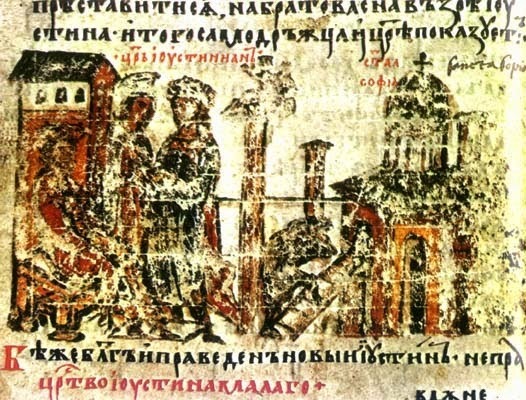
472 after being besieged in Rome by his own generals, Western Roman Emperor Anthemius was captured in the Old St. Peter's Basilica and put to death.
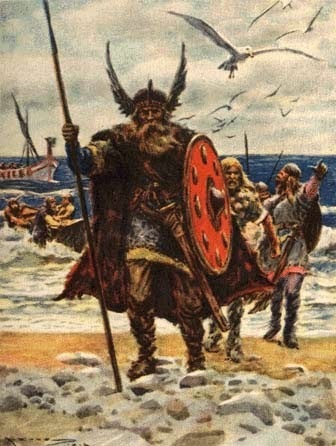
911 The Treaty of Saint-Clair-sur-Epte between Charles the Simple of France and Rollo leader of the Vikings was signed. The treaty protected Charles kingdom from further invasion and created the duchy of Normandy; the Vikings became known as Normans. Also Rollo agreed to be baptized and to marry the illegitimate daughter of Charles, thus becoming the king's vassal.
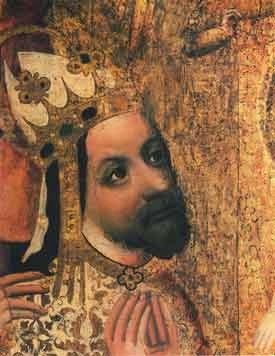
1346 Charles IV of Luxembourg was elected Holy Roman Emperor in Germany.

1533 Pope Clement VII excommunicated England's King Henry VIII.


472 after being besieged in Rome by his own generals, Western Roman Emperor Anthemius was captured in the Old St. Peter's Basilica and put to death.

911 The Treaty of Saint-Clair-sur-Epte between Charles the Simple of France and Rollo leader of the Vikings was signed. The treaty protected Charles kingdom from further invasion and created the duchy of Normandy; the Vikings became known as Normans. Also Rollo agreed to be baptized and to marry the illegitimate daughter of Charles, thus becoming the king's vassal.

1346 Charles IV of Luxembourg was elected Holy Roman Emperor in Germany.

1533 Pope Clement VII excommunicated England's King Henry VIII.

Published on July 11, 2014 05:20
The Briton and the Dane: Legacy featured on Booktrack

Read an excerpt accompanied to music
Note: The site can only be accessed using Chrome as your browser. Enjoyed reading The Briton and the Dane: Legacy with @Booktrack http://studio.booktrack.com/booktrack...

Published on July 11, 2014 05:20
July 10, 2014
The Briton and the Dane: Birthright featured on Booktrack

Read an excerpt accompanied to music
Note: The site can only be accessed using Chrome as your browser.
Enjoyed reading The Briton and the Dane: Birthright with @Booktrack http://studio.booktrack.com/booktrack...

Published on July 10, 2014 05:47
History Trivia - Lady Godiva rides naked on horseback through Coventry
July 10
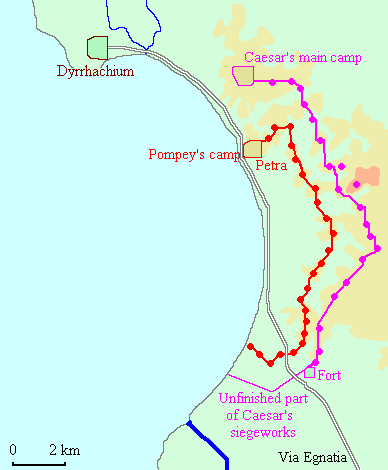
48 BC Battle of Dyrrhachium: Julius Caesar barely avoided a catastrophic defeat to Pompey in Macedonia.

138 Emperor Hadrian died of heart failure at Baiae at age 62; he was buried in Rome in the Tomb of Hadrian beside his late wife, Vibia Sabina.

988 The city of Dublin was founded on the banks of the river Liffey.

1040 Lady Godiva rode naked on horseback to force her husband, the Earl of Mercia, to lower taxes.
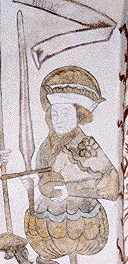
1086 Knut IV, the Saint, King of Denmark was murdered.

1099 El Cid, of Castile died.

1212 The most severe of several early fires of London burned most of the city to the ground.

1452 King James III of Scotland was born. 1

460 - Wars of Roses: Richard of York defeated King Henry VI at Northampton.

1520 King Charles V & King Henry VIII signed treaty of Calais.


48 BC Battle of Dyrrhachium: Julius Caesar barely avoided a catastrophic defeat to Pompey in Macedonia.

138 Emperor Hadrian died of heart failure at Baiae at age 62; he was buried in Rome in the Tomb of Hadrian beside his late wife, Vibia Sabina.

988 The city of Dublin was founded on the banks of the river Liffey.

1040 Lady Godiva rode naked on horseback to force her husband, the Earl of Mercia, to lower taxes.

1086 Knut IV, the Saint, King of Denmark was murdered.

1099 El Cid, of Castile died.

1212 The most severe of several early fires of London burned most of the city to the ground.

1452 King James III of Scotland was born. 1

460 - Wars of Roses: Richard of York defeated King Henry VI at Northampton.

1520 King Charles V & King Henry VIII signed treaty of Calais.

Published on July 10, 2014 05:45
July 9, 2014
Remains of long-lost temple discovered in Iraq
By Owen Jarus
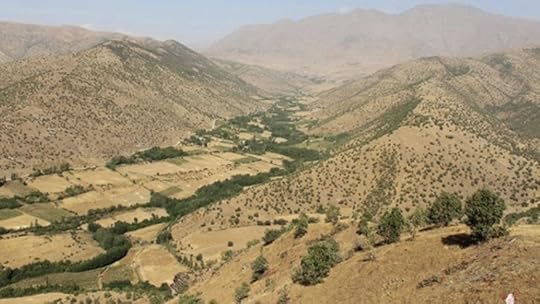 Life-size human statues and the remains of an ancient temple dating back some 2,500 years have been discovered in the Kurdistan region of northern Iraq. The region's hilly environment, shown here.Photo courtesy Dlshad Marf Zamua Life-size human statues and column bases from a long-lost temple dedicated to a supreme god have been discovered in the Kurdistan region of northern Iraq.
Life-size human statues and the remains of an ancient temple dating back some 2,500 years have been discovered in the Kurdistan region of northern Iraq. The region's hilly environment, shown here.Photo courtesy Dlshad Marf Zamua Life-size human statues and column bases from a long-lost temple dedicated to a supreme god have been discovered in the Kurdistan region of northern Iraq.
The discoveries date back over 2,500 years to the Iron Age, a time period when several groups such as the Urartians, Assyrians and Scythians vied for supremacy over what is now northern Iraq.
"I didn't do excavation, just archaeological soundings the villagers uncovered these materials accidentally," said Dlshad Marf Zamua, a doctoral student at Leiden University in the Netherlands, who began the fieldwork in 2005. The column bases were found in a single village while the other finds, including a bronze statuette of a wild goat, were found in a broad area south of where the borders of Iraq, Iran and Turkey intersect.
For part of the Iron Age, this area was under control of the city of Musasir, also called Ardini, Marf Zamua said. Ancient inscriptions have referred to Musasir as a "holy city founded in bedrock" and "the city of the raven."
A lost ancient temple"One of the best results of my fieldwork is the uncovered column bases of the long-lost temple of the city of Musasir, which was dedicated to the god Haldi," Marf Zamuatold Live Science in an email. Haldi was the supreme god of the kingdom of Urartu. His temple was so important that after the Assyrians looted it in 714 B.C., the Urartu king Rusa I was said to have ripped his crown off his head before killing himself.
He "threw himself on the ground, tore his clothes, and his arms hung limp. He ripped off his headband, pulled out his hair, pounded his chest with both hands, and threw himself flat on his face " reads one ancient account (translation by Marc Van De Mieroop).
The location of the temple has long been a mystery, but with the discovery of the column bases, Marf Zamua thinks it can be narrowed down. [Photos: Ancient Temple Discovered in Turkey]
Additionally, Marf Zamua analyzed an ancient carving of Musasir, discovered in the 19th century at Khorsabad. The carving, he found, shows hillside houses with three windows on the second floor and a doorway on the ground floor. Such a design can still be seen today in some villages, the bottom floor being used as a stable and storage area, he noted.
Life-size statuesThis long-lost temple is just the tip of the archaeological iceberg. During his work in Kurdistan, Marf Zamua also found several life-size human statues that are up to 7.5 feet tall. Made of limestone, basalt or sandstone, some of these statues are now partly broken.
They all show bearded males, some of whom "are holding a cup in their right hands, and they put their left hands on their bellies," said Marf Zamua. "One of them holds a hand ax. Another one put on a dagger."
Originally erected above burials, the statues have a "sad moment" posture, Marf Zamua said. Similar statues can be found from central Asia to eastern Europe. "It is art and ritual of nomads/pastorals, especially when they [buried] their chieftains," Marf Zamua said.
Mostof the newfound statues date to the seventh or sixth century B.C., after Musasir fell to the Assyrians, and during a time when the Scythians and Cimmerians were advancing through the Middle East.
Modern-day dangers and ancient treasuresOver the past few weeks, conflict in Iraq has been increasing as a group called the "Islamic State in Iraq and the Levant" (ISIS) has taken several cities and threatened to march on Baghdad. The Kurdistan area, including this archaeological site, is autonomous, and its militia has been able to prevent ISIS from entering it.
Marf Zamuasaid there are risks associated with living and working in the border area. Due to the conflicts of the past few decades, there are numerous unexploded land mines, one of which killed a young shepherd a month back, he said. Additionally the National Iraqi News Agency reports that Iranian artillery recently fired onto the Iraqi side of the border, and there have been past instances where planes from Turkey have launched attacks into Iraqi Kurdistan.
Despite these risks, there are also terrific archaeological finds to be made. In addition to the statues and column bases, Marf Zamuafound a bronze statuette of a wild goat about 3.3 inches long and 3.2 inches tall. Researchers are now trying to decipher a cuneiform inscription on the statuette.
Marf Zamua presented the discoveries recently in a presentation given at the International Congress on the Archaeology of the Ancient Near East, held at the University of Basel in Switzerland. In addition to his doctoral studies, Marf Zamua teaches at Salahaddin University in Erbil, which is the capital of Iraqi Kurdistan.
http://www.foxnews.com/science/2014/07/08/remains-long-lost-temple-discovered-in-iraq/

 Life-size human statues and the remains of an ancient temple dating back some 2,500 years have been discovered in the Kurdistan region of northern Iraq. The region's hilly environment, shown here.Photo courtesy Dlshad Marf Zamua Life-size human statues and column bases from a long-lost temple dedicated to a supreme god have been discovered in the Kurdistan region of northern Iraq.
Life-size human statues and the remains of an ancient temple dating back some 2,500 years have been discovered in the Kurdistan region of northern Iraq. The region's hilly environment, shown here.Photo courtesy Dlshad Marf Zamua Life-size human statues and column bases from a long-lost temple dedicated to a supreme god have been discovered in the Kurdistan region of northern Iraq.The discoveries date back over 2,500 years to the Iron Age, a time period when several groups such as the Urartians, Assyrians and Scythians vied for supremacy over what is now northern Iraq.
"I didn't do excavation, just archaeological soundings the villagers uncovered these materials accidentally," said Dlshad Marf Zamua, a doctoral student at Leiden University in the Netherlands, who began the fieldwork in 2005. The column bases were found in a single village while the other finds, including a bronze statuette of a wild goat, were found in a broad area south of where the borders of Iraq, Iran and Turkey intersect.
For part of the Iron Age, this area was under control of the city of Musasir, also called Ardini, Marf Zamua said. Ancient inscriptions have referred to Musasir as a "holy city founded in bedrock" and "the city of the raven."
A lost ancient temple"One of the best results of my fieldwork is the uncovered column bases of the long-lost temple of the city of Musasir, which was dedicated to the god Haldi," Marf Zamuatold Live Science in an email. Haldi was the supreme god of the kingdom of Urartu. His temple was so important that after the Assyrians looted it in 714 B.C., the Urartu king Rusa I was said to have ripped his crown off his head before killing himself.
He "threw himself on the ground, tore his clothes, and his arms hung limp. He ripped off his headband, pulled out his hair, pounded his chest with both hands, and threw himself flat on his face " reads one ancient account (translation by Marc Van De Mieroop).
The location of the temple has long been a mystery, but with the discovery of the column bases, Marf Zamua thinks it can be narrowed down. [Photos: Ancient Temple Discovered in Turkey]
Additionally, Marf Zamua analyzed an ancient carving of Musasir, discovered in the 19th century at Khorsabad. The carving, he found, shows hillside houses with three windows on the second floor and a doorway on the ground floor. Such a design can still be seen today in some villages, the bottom floor being used as a stable and storage area, he noted.
Life-size statuesThis long-lost temple is just the tip of the archaeological iceberg. During his work in Kurdistan, Marf Zamua also found several life-size human statues that are up to 7.5 feet tall. Made of limestone, basalt or sandstone, some of these statues are now partly broken.
They all show bearded males, some of whom "are holding a cup in their right hands, and they put their left hands on their bellies," said Marf Zamua. "One of them holds a hand ax. Another one put on a dagger."
Originally erected above burials, the statues have a "sad moment" posture, Marf Zamua said. Similar statues can be found from central Asia to eastern Europe. "It is art and ritual of nomads/pastorals, especially when they [buried] their chieftains," Marf Zamua said.
Mostof the newfound statues date to the seventh or sixth century B.C., after Musasir fell to the Assyrians, and during a time when the Scythians and Cimmerians were advancing through the Middle East.
Modern-day dangers and ancient treasuresOver the past few weeks, conflict in Iraq has been increasing as a group called the "Islamic State in Iraq and the Levant" (ISIS) has taken several cities and threatened to march on Baghdad. The Kurdistan area, including this archaeological site, is autonomous, and its militia has been able to prevent ISIS from entering it.
Marf Zamuasaid there are risks associated with living and working in the border area. Due to the conflicts of the past few decades, there are numerous unexploded land mines, one of which killed a young shepherd a month back, he said. Additionally the National Iraqi News Agency reports that Iranian artillery recently fired onto the Iraqi side of the border, and there have been past instances where planes from Turkey have launched attacks into Iraqi Kurdistan.
Despite these risks, there are also terrific archaeological finds to be made. In addition to the statues and column bases, Marf Zamuafound a bronze statuette of a wild goat about 3.3 inches long and 3.2 inches tall. Researchers are now trying to decipher a cuneiform inscription on the statuette.
Marf Zamua presented the discoveries recently in a presentation given at the International Congress on the Archaeology of the Ancient Near East, held at the University of Basel in Switzerland. In addition to his doctoral studies, Marf Zamua teaches at Salahaddin University in Erbil, which is the capital of Iraqi Kurdistan.
http://www.foxnews.com/science/2014/07/08/remains-long-lost-temple-discovered-in-iraq/

Published on July 09, 2014 17:01
Giant Ancient Sea Scorpions Had Bad Eyesight
By Tanya Lewis
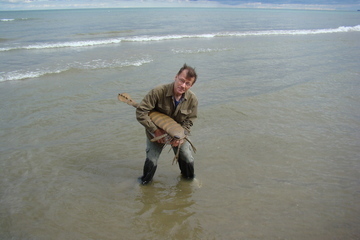
 Sam Ciurca, who collected the sea scorpion specimens, with a life size model of one called Acutiramus.
Sam Ciurca, who collected the sea scorpion specimens, with a life size model of one called Acutiramus.
Credit: Sam Ciurca
Gigantic sea scorpions that lurked in the ocean more than 400 million years ago weren't as scary as they sound, a new study suggests.
The massive creatures, known as pterygotids, were the largest arthropods that ever lived, growing to be up to 6.5 feet (2 meters) long, with claws measuring up to about 2 feet (0.6 m). But contrary to what scientists thought, these animals may not have been true top predators.
"These things were almost certainly still predators of some kind, but the imagined notion that they were swimming around terrorizing anything that looked edible is probably an exaggeration," said Derek Briggs, a paleontologist at Yale University in New Haven, Connecticut, and co-author of the new study, published today (July 8) in the journal Biology Letters.
Pterygotids were a type of eurypterid, an extinct type of sea scorpion related to arachnids. These ocean-dwelling creatures lived between about 436 million to 402 million years ago, in the Silurian and Devonian periods, Briggs said. Their closest living relatives are horseshoe crabs or modern sea scorpions, he said.
Previously, these spooky sea monsters were thought to be fearsome predators, devouring armored fishes and giant cephalopods (related to modern squids and nautiluses). Their compound eyes and large claws seemed to suggest as much.
But more recently, a study revealed that pterygotid claws wouldn't have been strong enough to break into armored fish or cephalopod shells.
In the recent study, Briggs and his team set out to examine the eyes of these ancient sea scorpions, to determine whether they had good enough vision to be great hunters.
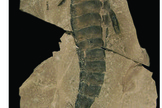 [image error]
[image error]
 A pterygotid fossil
A pterygotid fossil
Credit: copyright Division of Invertebrate Paleontology, Yale Peabody MuseumView full size imageSome of the lenses in the creatures' eyes were big enough for researchers to see them without any help from technology, but others had to be viewed under an electron microscope. The team estimated the angle between the lenses and the size of the lenses, comparing them with the eyes of a smaller eurypterid relative and of modern arthropods.
Briggs and his team concluded that the giant arthropods actually had poor eyesight. They probably lived near the bottom of the sea and likely hunted soft-bodied animals in dark waters or at night, Briggs said. But the fossil evidence limits these interpretations, so it's hard to know for sure how the animals behaved, he added.
After about 35 million years, pterygotids died out, and "it's a good thing they did," Brigg said. "They wouldn't be good company."
http://www.livescience.com/46708-ancient-sea-scorpions-bad-eyesight.html

 Sam Ciurca, who collected the sea scorpion specimens, with a life size model of one called Acutiramus.
Sam Ciurca, who collected the sea scorpion specimens, with a life size model of one called Acutiramus.Credit: Sam Ciurca
Gigantic sea scorpions that lurked in the ocean more than 400 million years ago weren't as scary as they sound, a new study suggests.
The massive creatures, known as pterygotids, were the largest arthropods that ever lived, growing to be up to 6.5 feet (2 meters) long, with claws measuring up to about 2 feet (0.6 m). But contrary to what scientists thought, these animals may not have been true top predators.
"These things were almost certainly still predators of some kind, but the imagined notion that they were swimming around terrorizing anything that looked edible is probably an exaggeration," said Derek Briggs, a paleontologist at Yale University in New Haven, Connecticut, and co-author of the new study, published today (July 8) in the journal Biology Letters.
Pterygotids were a type of eurypterid, an extinct type of sea scorpion related to arachnids. These ocean-dwelling creatures lived between about 436 million to 402 million years ago, in the Silurian and Devonian periods, Briggs said. Their closest living relatives are horseshoe crabs or modern sea scorpions, he said.
Previously, these spooky sea monsters were thought to be fearsome predators, devouring armored fishes and giant cephalopods (related to modern squids and nautiluses). Their compound eyes and large claws seemed to suggest as much.
But more recently, a study revealed that pterygotid claws wouldn't have been strong enough to break into armored fish or cephalopod shells.
In the recent study, Briggs and his team set out to examine the eyes of these ancient sea scorpions, to determine whether they had good enough vision to be great hunters.
 [image error]
[image error]
 A pterygotid fossil
A pterygotid fossilCredit: copyright Division of Invertebrate Paleontology, Yale Peabody MuseumView full size imageSome of the lenses in the creatures' eyes were big enough for researchers to see them without any help from technology, but others had to be viewed under an electron microscope. The team estimated the angle between the lenses and the size of the lenses, comparing them with the eyes of a smaller eurypterid relative and of modern arthropods.
Briggs and his team concluded that the giant arthropods actually had poor eyesight. They probably lived near the bottom of the sea and likely hunted soft-bodied animals in dark waters or at night, Briggs said. But the fossil evidence limits these interpretations, so it's hard to know for sure how the animals behaved, he added.
After about 35 million years, pterygotids died out, and "it's a good thing they did," Brigg said. "They wouldn't be good company."
http://www.livescience.com/46708-ancient-sea-scorpions-bad-eyesight.html

Published on July 09, 2014 16:56
Pocket Pets? Mini Hedgehog and Tiny Tapir Fossils Found in Canada
By Stephanie Pappas,
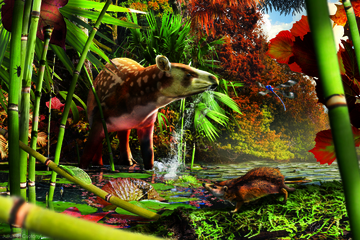
 An artist's reconstruction shows a newfound tapiroid drinking in the shallows of an Eocene lake in British Columbia, with the small, newly identified, proto-hedgehog in the foreground.
An artist's reconstruction shows a newfound tapiroid drinking in the shallows of an Eocene lake in British Columbia, with the small, newly identified, proto-hedgehog in the foreground.
Credit: Illustration © by Julius T. Csotonyi
A miniature hedgehog smaller than a mouse and a pint-sized tapir are the first mammals ever found at a fossil site in British Columbia known for exquisitely preserved plants, insects and fish.
The new fossils date back about 50 million to 53 million years ago, to the warm Eocene Epoch, when British Columbia's climate was similar to that of Portland, Oregon, today. These are the first two mammals ever found at the dig site in Driftwood Canyon Provincial Park, and they fill in a gap the size of Canada.
"We know a lot about this time interval in Wyoming and Colorado. We know a bit about it in the high Arctic," said study researcher Jaelyn Eberle, the curator of fossil vertebrates at the University of Colorado Museum of Natural History. "But we know nothing about what was going on in between."
Fossil surprise
Scientists made this gap-filling discovery by accident. Study researcher David Greenwood of Brandon University in Manitoba and his colleagues were quarrying for plant fossils in the lakebed shales of Driftwood Canyon Provincial Park, when a student cracked open a rock and found a miniscule bone inside. [See Images of the New Hedgehog & Tapir Fossils]
"When they looked at it under a hand lens, they realized it was a fossil vertebrate," Eberle told Live Science. The bone turned out to be a partial jaw and some teeth belonging to a previously unknown species of hedgehog, dubbed Silvacola acares, from the words for "tiny forest dweller" in Greek and Latin.
This little hedgehog would have been only about 2 inches (5 centimeters) long, smaller than a house mouse. Its molars were a mere millimeter (0.04 inches) long, so small that paleontologists declined to chip the animal's tiny jaw from the rock surrounding it. Instead, the study researchers sent the whole hunk to Penn State University to be scanned with high-resolution computed tomography (CT), a technique that yields virtual slices of the interior of an object.
The tapir was equally surprising. Greenwood and his colleagues found it in coal-rich rock beds in the park, the site of a swampy spot in the Eocene and a rare place to find vertebrate fossils.
"It was just kind of, 'Whoa, not expected,'" Eberle said.
Balmy British Columbia
The tapir is a species of the Heptodon genus, which is part of a group that is the oldest in the tapir lineage. Species of Heptodon would have been about half the size of modern tapirs, which weigh around 330 to 660 pounds (150 to 300 kilograms). (During the time these creatures lived, other animals were pipsqueaks, too — the earliest known horse, which started out evolutionarily the size of a mini schnauzer, shrunk to housecat size during the warmest part of the early Eocene.) Heptodon probably ate leaves, which makes sense as it shows up in many forested Eocene environments, Eberle said.
The early Eocene was a steamy time on Earth. The breakup of the supercontinent Pangea came with no small amount of volcanic activity, which released billions of tons of carbon dioxide into the atmosphere. These emissions, among other greenhouse gases, heated the globe by about 11 degrees Fahrenheit (6 degrees Celsius) over roughly 20,000 years. The areas that now comprise Colorado and Wyoming hosted tropical rainforests, and ferns and trees thrived in the Arctic.
"This is the height of global warming since the extinction of the dinosaurs, so it's the time interval that people look at a lot for trying to understand global warming today," Eberles said.
A forest of mixed conifer and broadleaf trees carpeted Northern British Columbia, with palms and spruce living side-by-side, Eberle said. It would have rained often and frozen rarely, not unlike the climate in Portland today, 700 miles (1,126 kilometers) to the south.
"British Columbia is adding a new dimension to that time interval," Eberle said. "Not everything was hot and tropical."
The researchers reported their findings today (July 8) in the Journal of Vertebrate Paleontology.
http://www.livescience.com/46700-tapir-hedgehog-fossils-discovered.html

 An artist's reconstruction shows a newfound tapiroid drinking in the shallows of an Eocene lake in British Columbia, with the small, newly identified, proto-hedgehog in the foreground.
An artist's reconstruction shows a newfound tapiroid drinking in the shallows of an Eocene lake in British Columbia, with the small, newly identified, proto-hedgehog in the foreground.Credit: Illustration © by Julius T. Csotonyi
A miniature hedgehog smaller than a mouse and a pint-sized tapir are the first mammals ever found at a fossil site in British Columbia known for exquisitely preserved plants, insects and fish.
The new fossils date back about 50 million to 53 million years ago, to the warm Eocene Epoch, when British Columbia's climate was similar to that of Portland, Oregon, today. These are the first two mammals ever found at the dig site in Driftwood Canyon Provincial Park, and they fill in a gap the size of Canada.
"We know a lot about this time interval in Wyoming and Colorado. We know a bit about it in the high Arctic," said study researcher Jaelyn Eberle, the curator of fossil vertebrates at the University of Colorado Museum of Natural History. "But we know nothing about what was going on in between."
Fossil surprise
Scientists made this gap-filling discovery by accident. Study researcher David Greenwood of Brandon University in Manitoba and his colleagues were quarrying for plant fossils in the lakebed shales of Driftwood Canyon Provincial Park, when a student cracked open a rock and found a miniscule bone inside. [See Images of the New Hedgehog & Tapir Fossils]
"When they looked at it under a hand lens, they realized it was a fossil vertebrate," Eberle told Live Science. The bone turned out to be a partial jaw and some teeth belonging to a previously unknown species of hedgehog, dubbed Silvacola acares, from the words for "tiny forest dweller" in Greek and Latin.
This little hedgehog would have been only about 2 inches (5 centimeters) long, smaller than a house mouse. Its molars were a mere millimeter (0.04 inches) long, so small that paleontologists declined to chip the animal's tiny jaw from the rock surrounding it. Instead, the study researchers sent the whole hunk to Penn State University to be scanned with high-resolution computed tomography (CT), a technique that yields virtual slices of the interior of an object.
The tapir was equally surprising. Greenwood and his colleagues found it in coal-rich rock beds in the park, the site of a swampy spot in the Eocene and a rare place to find vertebrate fossils.
"It was just kind of, 'Whoa, not expected,'" Eberle said.
Balmy British Columbia
The tapir is a species of the Heptodon genus, which is part of a group that is the oldest in the tapir lineage. Species of Heptodon would have been about half the size of modern tapirs, which weigh around 330 to 660 pounds (150 to 300 kilograms). (During the time these creatures lived, other animals were pipsqueaks, too — the earliest known horse, which started out evolutionarily the size of a mini schnauzer, shrunk to housecat size during the warmest part of the early Eocene.) Heptodon probably ate leaves, which makes sense as it shows up in many forested Eocene environments, Eberle said.
The early Eocene was a steamy time on Earth. The breakup of the supercontinent Pangea came with no small amount of volcanic activity, which released billions of tons of carbon dioxide into the atmosphere. These emissions, among other greenhouse gases, heated the globe by about 11 degrees Fahrenheit (6 degrees Celsius) over roughly 20,000 years. The areas that now comprise Colorado and Wyoming hosted tropical rainforests, and ferns and trees thrived in the Arctic.
"This is the height of global warming since the extinction of the dinosaurs, so it's the time interval that people look at a lot for trying to understand global warming today," Eberles said.
A forest of mixed conifer and broadleaf trees carpeted Northern British Columbia, with palms and spruce living side-by-side, Eberle said. It would have rained often and frozen rarely, not unlike the climate in Portland today, 700 miles (1,126 kilometers) to the south.
"British Columbia is adding a new dimension to that time interval," Eberle said. "Not everything was hot and tropical."
The researchers reported their findings today (July 8) in the Journal of Vertebrate Paleontology.
http://www.livescience.com/46700-tapir-hedgehog-fossils-discovered.html

Published on July 09, 2014 16:45
Mr. Chuckles bumped into Devorah Fox at The Wizard's Cauldron
 The Wizard speaks:
The Wizard speaks:Devorah Fox, a New York born, now Texas based writer, appeared on the Cauldron last year and the interview was one of the surprise hits of that period - indeed, any period! #
Personable, funny, exceptionally professional, when I found out Devorah was planning to release her latest work "The King's Redress", I wasted no time in picking up the Wizphone to ask her to come back on the show. Click on the link to read more: http://greenwizard62.blogspot.co.uk/2014/07/sandcastles-sharks-swords-and-sceptres.html

Published on July 09, 2014 08:55



